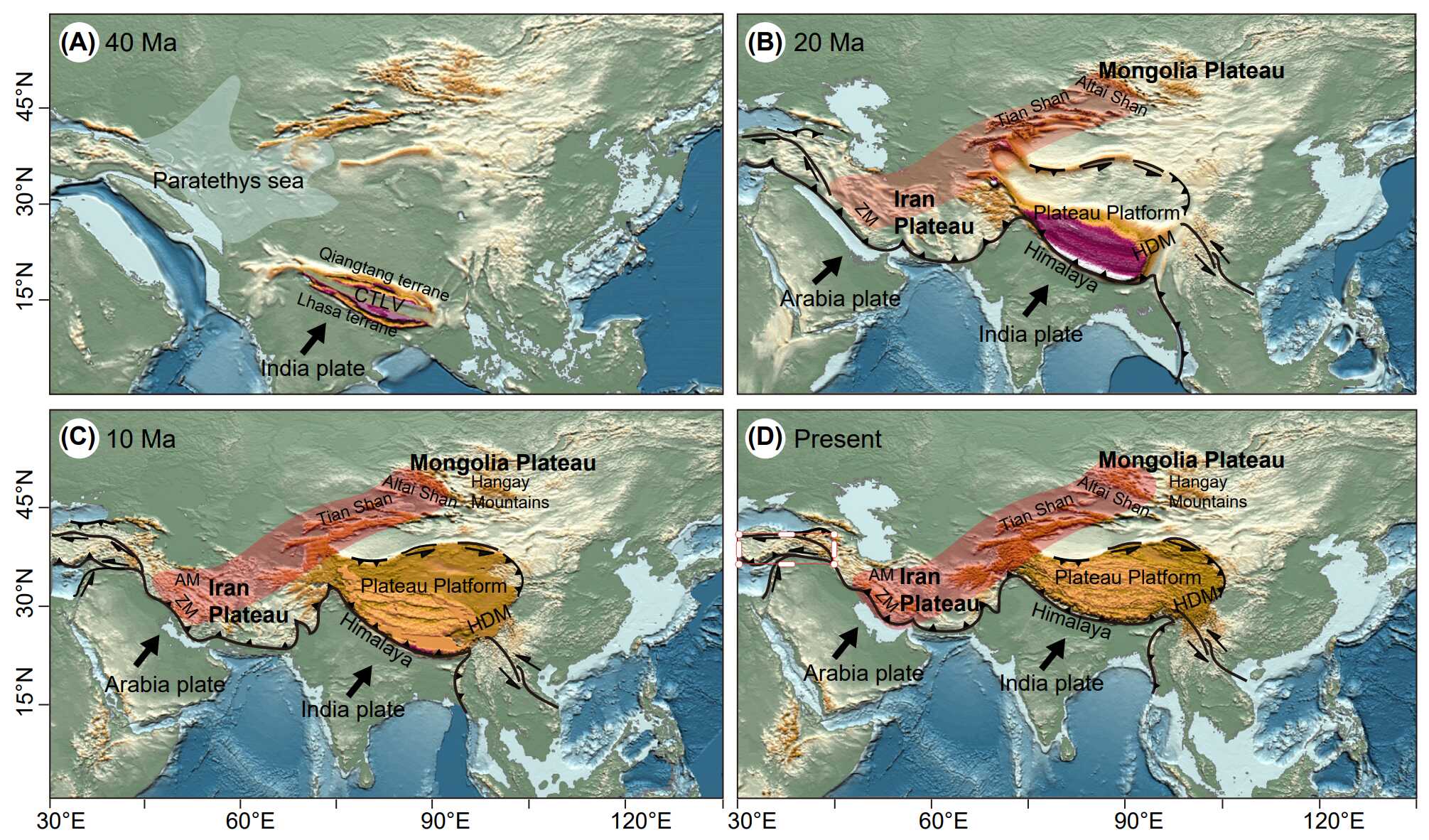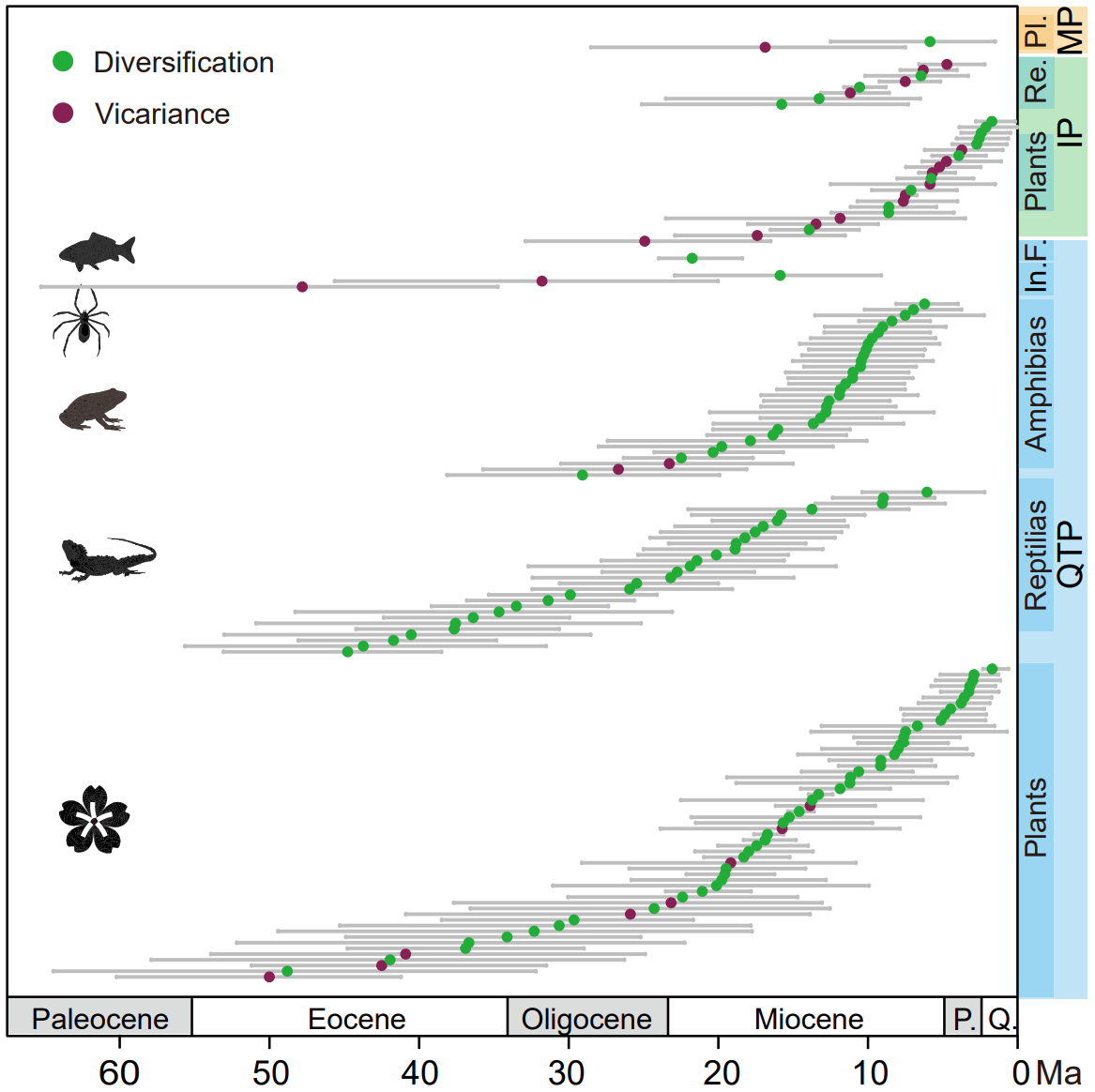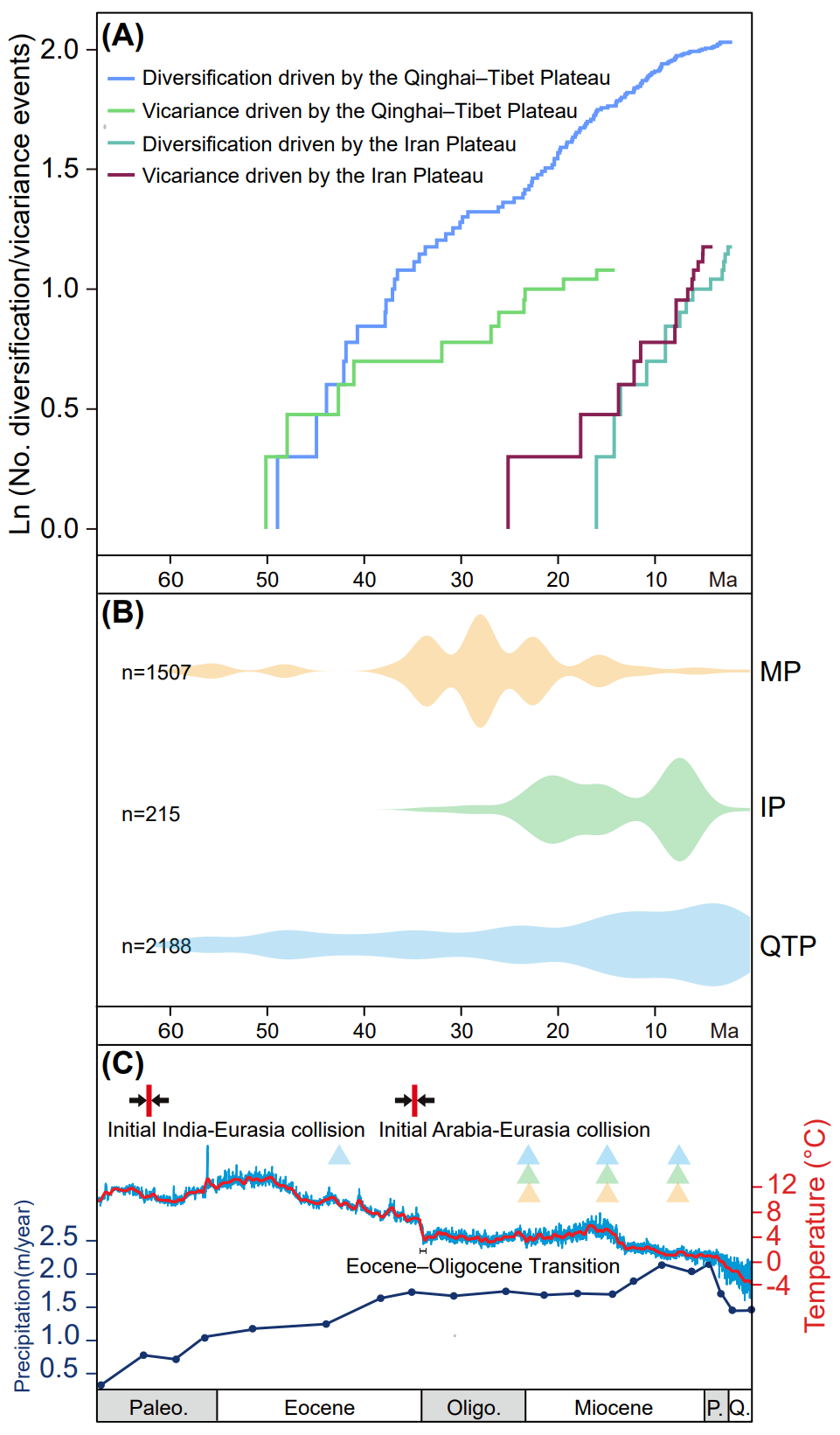A team led by Prof. WANG Wei from the Institute of Botany of the Chinese Academy of Sciences (IBCAS) emphasizes that the formation of the three great Asian plateaus is a major driver for change in Asian landscape and biotas. The study was published recently in Trends in Ecology & Evolution.
The three great Asian plateaus—the Qinghai–Tibet Plateau (QTP), the Iran Plateau (IP), and the Mongolia Plateau (MP) — together with their adjacent regions form the planet's largest contiguous highland system and cradle the richest temperate alpine biotas on earth. This mountain belt houses five global biodiversity hotspots of great conservation value and is highly sensitive to global warming. Yet the original timing and evolutionary drivers of this biodiversity remain poorly resolved.
In this study, the researchers analyzed 123 diversification events and 28 vicariance events from 45 organismal groups (covering pteridophytes, gymnosperms, angiosperms, amphibians, reptiles, invertebrates, and fishes) to explore how ecosystems and biodiversity have evolved across the three plateaus and adjacent areas. Integrating these data with geological, ecological, and paleontological evidence, they show that the plateaus underwent multiple-stage uplift throughout the Cenozoic; these geological events have greatly reshaped Asia's topography and altered regional and even global climate, thereby driving evolutionary radiations across the plateaus and their neighboring areas. Consequently, biodiversity of the three plateau regions was not a product of the Pleistocene ice age, but has experienced a long and complex evolutionary process, with the Neogene serving as a critical interval for biotic modernization.
Among the three plateaus, the QTP harbors the most ancient evolutionary history and therefore the oldest biotic components.
Comparative analyses of vascular plant diversity reveal markedly different present-day richness across the three plateaus: the QTP hosts the greatest species richness, followed by the IP and then the MP. However, current protected areas do not fully cover the species diversity hotspots of the three plateaus. Only the QTP's Plateau Platform meets the Kunming-Montreal Global Biodiversity Framework target (>30%).
The researchers propose four priority research directions: 1) coordinated efforts to explore abiotic and/or biotic drivers of biodiversity; 2) multi-taxon studies evaluating the relative roles of colonization and in-situ speciation to this biodiversity; 3) molecular-phylogenetic and palaeontological work focus on species-rich but under-sampled areas and/or taxa; 4) integrative analyses that treat the three plateaus as a single biogeographic unit to explore inter-plateau biodiversity relationships.
The study systematically reviews the geological development of the three great Asian plateaus and the evolutionary dynamics of their biodiversity, significantly enhancing our understanding of the region's geological evolution and biodiversity history. Meanwhile, it highlights substantial conservation gaps that must be addressed to safeguard this irreplaceable biodiversity.

Paleogeographic maps of the three great Asian plateaus in the Cenozoic (Image by IBCAS)

A plot of the tempo of 123 diversification and 28 vicariance events for the 45 organismal groups on the three great Asian plateaus (Image by IBCAS)

Biotic evolution in relation to the climate and geological history of the three great Asian plateaus (Image by IBCAS)
A team led by Prof. WANG Wei from the Institute of Botany of the Chinese Academy of Sciences (IBCAS) emphasizes that the formation of the three great Asian plateaus is a major driver for change in Asian landscape and biotas. The study was published recently in Trends in Ecology & Evolution.
The three great Asian plateaus—the Qinghai–Tibet Plateau (QTP), the Iran Plateau (IP), and the Mongolia Plateau (MP) — together with their adjacent regions form the planet's largest contiguous highland system and cradle the richest temperate alpine biotas on earth. This mountain belt houses five global biodiversity hotspots of great conservation value and is highly sensitive to global warming. Yet the original timing and evolutionary drivers of this biodiversity remain poorly resolved.
In this study, the researchers analyzed 123 diversification events and 28 vicariance events from 45 organismal groups (covering pteridophytes, gymnosperms, angiosperms, amphibians, reptiles, invertebrates, and fishes) to explore how ecosystems and biodiversity have evolved across the three plateaus and adjacent areas. Integrating these data with geological, ecological, and paleontological evidence, they show that the plateaus underwent multiple-stage uplift throughout the Cenozoic; these geological events have greatly reshaped Asia's topography and altered regional and even global climate, thereby driving evolutionary radiations across the plateaus and their neighboring areas. Consequently, biodiversity of the three plateau regions was not a product of the Pleistocene ice age, but has experienced a long and complex evolutionary process, with the Neogene serving as a critical interval for biotic modernization.
Among the three plateaus, the QTP harbors the most ancient evolutionary history and therefore the oldest biotic components.
Comparative analyses of vascular plant diversity reveal markedly different present-day richness across the three plateaus: the QTP hosts the greatest species richness, followed by the IP and then the MP. However, current protected areas do not fully cover the species diversity hotspots of the three plateaus. Only the QTP's Plateau Platform meets the Kunming-Montreal Global Biodiversity Framework target (>30%).
The researchers propose four priority research directions: 1) coordinated efforts to explore abiotic and/or biotic drivers of biodiversity; 2) multi-taxon studies evaluating the relative roles of colonization and in-situ speciation to this biodiversity; 3) molecular-phylogenetic and palaeontological work focus on species-rich but under-sampled areas and/or taxa; 4) integrative analyses that treat the three plateaus as a single biogeographic unit to explore inter-plateau biodiversity relationships.
The study systematically reviews the geological development of the three great Asian plateaus and the evolutionary dynamics of their biodiversity, significantly enhancing our understanding of the region's geological evolution and biodiversity history. Meanwhile, it highlights substantial conservation gaps that must be addressed to safeguard this irreplaceable biodiversity.

Paleogeographic maps of the three great Asian plateaus in the Cenozoic (Image by IBCAS)

A plot of the tempo of 123 diversification and 28 vicariance events for the 45 organismal groups on the three great Asian plateaus (Image by IBCAS)

Biotic evolution in relation to the climate and geological history of the three great Asian plateaus (Image by IBCAS)
